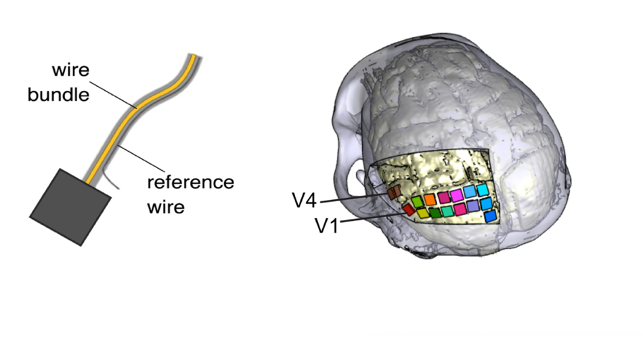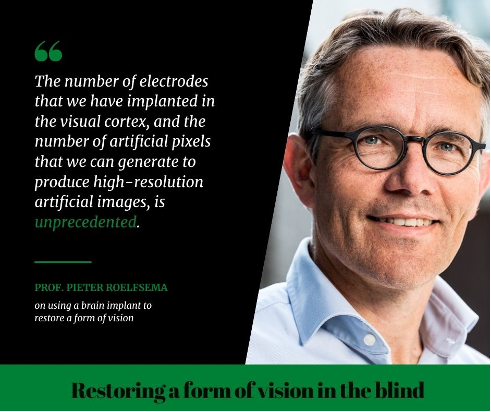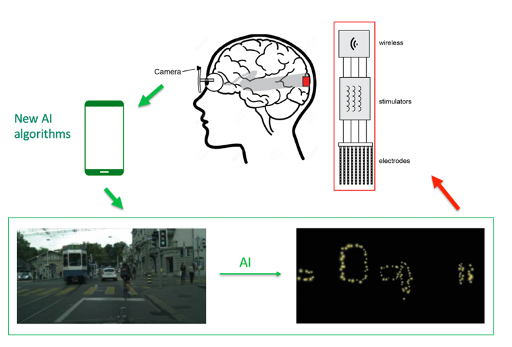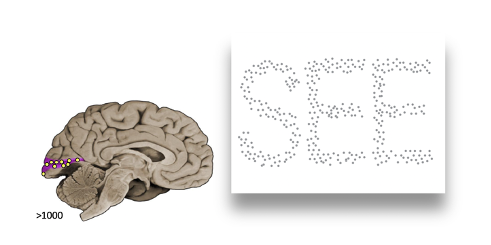HBP-supported innovation: A brain prosthesis for the blind
03 December 2020
Human Brain Project research has helped lay the foundation for a brain implant that could one day give blind people their sight back. Recent discoveries at the Netherlands Institute for Neuroscience (NIN) show that in monkeys, newly developed high-resolution implants in the visual cortex make it possible to recognize artificially induced images. The findings were published in Science on 3 December. For further development towards application in humans, the high-resolution 3D digital brain atlases of HBP’s EBRAINS Research Infrastructure will become instrumental.
There are around 40 million blind people in the world. Many of them would not benefit from a treatment of the eyes, e.g. in cases with damage to the optical nerve, where the connection between eye and brain is lost. For these patients, direct stimulation of the visual areas in the back of the brain could be the answer.
The idea of stimulating the brain via an implant to generate artificial visual percepts is not new and dates back to the 1970s. However, existing systems are only able to generate a small number of artificial ‘pixels’ at a time. At the NIN, researchers from a team led by Pieter Roelfsema are now using new implant production and implantation technologies, cutting-edge materials engineering, microchip fabrication, and microelectronics, to develop devices that are more stable and durable than previous implants.

© NIN
Electrical stimulation
When electrical stimulation is delivered to the brain via an implanted electrode, it generates the percept of a dot of light at a particular location in visual space, known as a ‘phosphene.’
The team developed high-resolution implants consisting of 1024 electrodes and implanted them in the visual cortex of two sighted monkeys. Their goal was to create interpretable images by delivering electrical stimulation simultaneously via multiple electrodes, to generate a percept that was composed of multiple phosphenes. “The number of electrodes that we have implanted in the visual cortex, and the number of artificial pixels that we can generate to produce high-resolution artificial images, is unprecedented,” says Roelfsema.
Recognizing dots, lines and letters
The monkeys first had to perform a simple behavioral task in which they made eye movements to report the location of a phosphene that was elicited during electrical stimulation via an individual electrode. They were also tested on more complex tasks such as a direction-of-motion task, in which micro-stimulation was delivered on a sequence of electrodes, and a letter discrimination task, in which micro-stimulation was delivered on 8-15 electrodes simultaneously, creating a percept in the form of a letter. The monkeys successfully recognized shapes and percepts, including lines, moving dots, and letters, using their artificial vision.
“Our implant interfaces directly with the brain, bypassing prior stages of visual processing via the eye or the optic nerve. Hence, in the future, such technology could be used for the restoration of low vision in blind people who have suffered injury or degeneration of the retina, eye, or optic nerve, but whose visual cortex remains intact,” explains Xing Chen, postdoctoral researcher in Roelfsema’s team.
This research lays the foundations for a neuroprosthetic device that could allow profoundly blind people to regain functional vision and to recognize objects, navigate in unfamiliar surroundings, and interact more easily in social settings, significantly improving their independence and quality of life.
“Not only was part of this work funded by Human Brain Project, the future implant design for humans will also benefit from the EBRAINS brain atlases”, says Roelfsema. “If you want to interface with the cortex in this highly precise way, you need a very detailed map.”
“It’s always our goal to help bring life-changing innovations from brain research to patients. Research like this bridges the gap from basic research to life-changing brain-based technology”, says Katrin Amunts, Scientific Research Director of the Human Brain Project.
“This is a great example of progress in the amazing field of brain computer interfaces, and we aim to make EBRAINS a major hub and accelerator for such research in Europe”, says EBRAINS CEO Pawel Swieboda.
Press Release at NIN: Restoring a rudimentary form of vision in the blind
Original Publication
Shape perception via a high-channel-count neuroprosthesis in monkey visual cortex Chen et al., Science 04 Dec 2020: Vol. 370, Issue 6521, pp. 1191-1196 DOI: 10.1126/science.abd7435
The work was supported by the Netherlands Organisation for Scientific Research (STW-Perspectief P15-42 “NESTOR”), the European Union FP7 (ERC 339490 “Cortic_al_gorithms”), the Human Brain Project (agreements 720270 and 785907, “Human Brain Project SGA1 and SGA2”) and the Friends Foundation of the Netherlands Institute for Neuroscience.
Contact
Pieter Roelfsema
p.roelfsema@nin.knaw.nl
+31 638634477
HBP Public Relations
Peter Zekert
+49 2461 61 96860
press@humanbrainproject.eu
Images:

© NIN

© NIN

© NIN
Futher Links:

EBRAINS’ ambition is to enable a new era in brain research. Find out more about the shared digital brain research infrastructure of the EU
https://ebrains.eu/discover
Watch the EBRAINS “Brain Matters” Webinar
Networks for Consciousness & Medical Use Cases
with Mavi Sanchez-Vives, Marcello Massimini and Pieter Roelfsema



